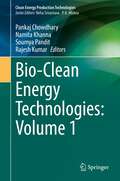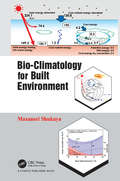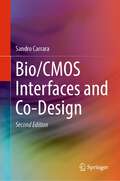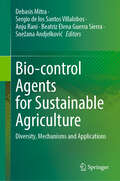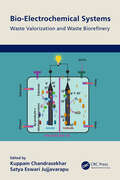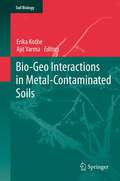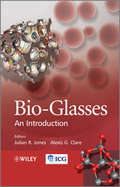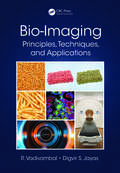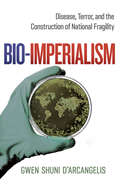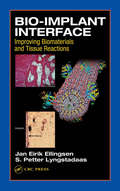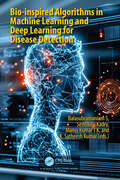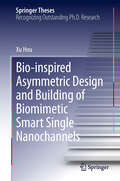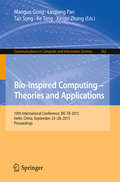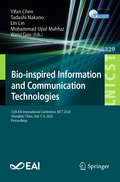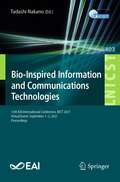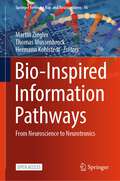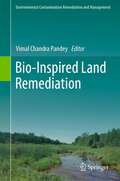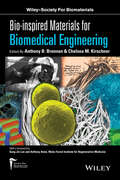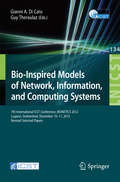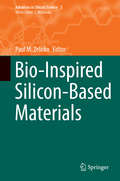- Table View
- List View
Bio-Clean Energy Technologies: Volume 1 (Clean Energy Production Technologies)
by Pankaj Chowdhary Namita Khanna Soumya Pandit Rajesh KumarThis book discusses the latest advancements in the area of biofuel development. It covers extensive information regarding different aspects and types of biofuels. The book provides a road map of the various different kinds of biofuels available for consideration, including both conventional and advanced algal based biofuels, replete with the economic analysis of their production and implementation. The contributors are experienced professors, academicians and scientists associated with renowned laboratories and institutes in India and abroad. This book is of interest to teachers, researchers, biofuel scientists, capacity builders and policymakers. Also the book serves as additional reading material for undergraduate and graduate students. National and international scientists, policy makers will also find this to be a useful read.
Bio-Clean Energy Technologies Volume 2 (Clean Energy Production Technologies)
by Pankaj Chowdhary Soumya Pandit Namita KhannaThis edited book discusses the latest advancements in the area of biofuel development. It covers extensive information regarding different aspects and types of biofuels. The book provides a road map of the various kinds of biofuels available for consideration. It focuses on microbial based power generation, applications of nanotechnology in biofuel development, advancements in molecular techniques, economic and life cycle assessments. The book also highlights the commercialization prospects and economics of the various processes and an overview of the life cycle assessment of the various different kinds of biofuels. The contributors are experienced professors, academicians and scientists associated with renowned laboratories and institutes in India and abroad. This book is of interest to teachers, researchers, biofuel scientists, capacity builders and policymakers. Also the book serves as additional reading material for undergraduate and graduate students. National and international scientists, policy makers will also find this to be a useful read.
Bio-Climatology for Built Environment
by Masanori ShukuyaIndoor climate is determined by rational lighting, heating, cooling and ventilating systems. For occupants' well-being it should be consistent with how regional outdoor climate works in the flow of radiation via four paths of heat transfer: radiation; convection; conduction; and evaporation. This book starts with the relationship between the human body and its immediate environmental space followed by a brief introduction of passive and active systems for indoor climate conditioning. The nature of light and heat is discussed with a focus on building envelope systems such as walls and windows, and then examined from the viewpoint of thermodynamics and human-biology. Some examples are given to enable a better understanding of luminous and thermal characteristics of our most immediate environment particularly for those professionally involved in environmental planning, designing, and engineering to know about bio-climatic design principle.
Bio/CMOS Interfaces and Co-Design
by Sandro CarraraThis textbook demonstrates new paradigms for the interface between CMOS circuits and the biological world. A deep theoretical description of such an interface is defined and discussed, while various real applications are demonstrated by also discussing several analog CMOS circuits. Electrochemical techniques are proposed in detail to learn how to design integrated biosensors. Biological materials are described to provide devices selectivity. Nanoscale materials are discussed to provide device sensitivity. CMOS circuits are analyzed to provide real applications. Extensive examples with solutions are provided, as well as exercises at the end of each chapter. This book introduces students to the state-of-the-art in Bio/CMOS interfaces, describing leading-edge research in CMOS design and VLSI development for applications requiring intimate integration of biological molecules onto the chip. It provides multidisciplinary content ranging from biochemistry to CMOS design in order to address Bio/CMOS interface co-design in biosensing applications.
Bio-control Agents for Sustainable Agriculture: Diversity, Mechanisms and Applications
by Debasis Mitra Sergio de los Santos Villalobos Anju Rani Beatriz Elena Guerra Sierra Snežana AndjelkovićThis book covers all aspects of the diversity and core microbiome of the bio-control agents. Their bioprospecting and application at the field level is also discussed. The application of bio-control agents is unique in plant production due to various reasons, including its environment-friendly nature, management of plant resistance and incentivizing the rhizosphere to phyllosphere signaling. The chapters provide information on major plant-associated diversity of beneficial microorganisms, various pathogen management strategies, and improving plant immunity by the application of bio-control agents. Additionally, the exploitation, development, and quality control of bio-control agent-based formulations for farming systems and industrial-level production is discussed. This approach provides a novel framework for fostering sustainable development in crop production and protection. The book targets researchers, microbiology students, the biofertilizers industry, and those in agricultural and environmental fields.
Bio-Electrochemical Systems: Waste Valorization and Waste Biorefinery
by Kuppam ChandrasekharThis book addresses electro-fermentation for biofuel production and generation of high-value chemicals and biofuels using organic wastes. It covers the use of microbial biofilm and algae-based bioelectrochemical systems (BESs) for bioremediation and co-generation of valuable chemicals, including their practical applications. It explains BES design, integrated approaches to enhance process efficiency, and scaling-up technology for waste remediation, bio-electrogenesis, and resource recovery from wastewater. Features: Provides information regarding bioelectrochemical systems, mediated value-added chemical synthesis, and waste remediation and resource recovery approaches. Covers the use of microbial biofilm and algae-based bioelectrochemical systems for bioremediation and co-generation of valuable chemicals. Explains waste-to-energy related concepts to treat industrial effluents along with bioenergy generation. Deals with various engineering approaches for chemicals production in eco-friendly manner. Discusses emerging electro-fermentation technology. This book is aimed at senior undergraduates and researchers in industrial biotechnology, environmental science, civil engineering, chemical engineering, bioenergy and biofuels, and wastewater treatment.
Bio#Futures: Foreseeing and Exploring the Bioeconomy
by Emmanuel Koukios Anna Sacio-SzymańskaThis volume presents a timely recognition, warning and mapping of the fast approaching wave, or “bio-tsunami”, of global socio-technical transformation, built by a much wider spectrum of converging powers, including biotechnology, new agriculture, novel foods, health, quality of life, environment, energy, sustainability, education, knowledge management, and design of smart applications. The book contains eight sections corresponding to different clusters of bioeconomic and socio-technical change, as identified by the editors’ “Scanning the Horizon” foresight research; it also offers an integrated view of the future bioeconomy landscape though the convergence of several technologies that affect everyday life. The clusters offer methodologies for forecasting the future bioeconomy, and how these predictions can affect target-setting and the orientation of policies and actions to manage cultural and societal change, and achieve sustainable development in less developed areas. The book will be of interest to researchers, producers, logistics experts, policy makers, regulators, business and financial institutions, and biotechnologists (e.g. geneticists, food experts, etc.).
Bio-Geo Interactions in Metal-Contaminated Soils (Soil Biology #31)
by Ajit Varma Erika KotheMetal contamination is an increasing ecological and eco-toxicological risk. Understanding the processes involved in metal mobilization, sorption and mineralization in soils are key features for soil bioremediation. Following an introduction to the physical, chemical and biological components of contaminated soils, various chapters address the interactions of soil, microorganisms, plants and the water phase necessary to transfer metals into biological systems. These include topics such as potential hazards at mining sites; rare earth elements in biotic and abiotic acidic systems; manganese redox reactions; biomineralisation, uranium in seepage water; metal-resistant streptomycetes; mycorrhiza in re-forestation; metal (hyper)accummulation in plants; microbial metal uptake; and their potential for bioremediation. This book will be of interest to soil biologists, geologists and chemists, researchers and graduate students, as well as consulting companies and small enterprises involved in bioremediation.
Bio-Glasses: An Introduction
by Alexis Clare Julian JonesThis new work is dedicated to glasses and their variants which can be used as biomaterials to repair diseased and damaged tissues. Bio-glasses are superior to other biomaterials in many applications, such as healing bone by signaling stem cells to become bone cells. Key features: First book on biomaterials to focus on bio-glassesEdited by a leading authority on bio-glasses trained by one of its inventors, Dr Larry HenchSupported by the International Commission on Glass (ICG)Authored by members of the ICG Biomedical Glass Committee, with the goal of creating a seamless textbookWritten in an accessible style to facilitate rapid absorption of informationCovers all types of glasses, their properties and applications, and demonstrates how glass is an attractive improvement to current proceduresOf interest to the biomedical as well as the materials science community. The book covers all types of glasses: traditional glasses, bioactive glasses, sol-gel glasses, phosphate glasses, glass-ceramics, composites and hybrids. Alongside discussion on how bio-glasses are made, their properties, and the reasons for their use, the authors also cover their applications in dentistry, bone regeneration and tissue engineering and cancer treatment. Its solid guidance describes the steps needed to take a new material from concept to clinic, covering the essentials of patenting, scale-up, quality assurance and FDA approval.
Bio-Imaging: Principles, Techniques, and Applications
by Rajagopal Vadivambal Digvir S. JayasHighlights the Emergence of Image Processing in Food and AgricultureIn addition to uses specifically related to health and other industries, biological imaging is now being used for a variety of applications in food and agriculture. Bio-Imaging: Principles, Techniques, and Applications fully details and outlines the processes of bio-imaging applica
Bio-Imperialism: Disease, Terror, and the Construction of National Fragility
by Gwen Shuni D'ArcangelisBio-Imperialism focuses on an understudied dimension of the war on terror: the fight against bioterrorism. This component of the war enlisted the biosciences and public health fields to build up the U.S. biodefense industry and U.S. global disease control. The book argues that U.S. imperial ambitions drove these shifts in focus, aided by gendered and racialized discourses on terrorism, disease, and science. These narratives helped rationalize American research expansion into dangerous germs and bioweapons in the name of biodefense and bolstered the U.S. rationale for increased interference in the disease control decisions of Global South nations. Bio-Imperialism is a sobering look at how the war on terror impacted the world in ways that we are only just starting to grapple with.
Bio-Implant Interface: Improving Biomaterials and Tissue Reactions
by J.E. Ellingsen S.P. LyngstadaasAchieving good clinical outcomes with implanted biomaterials depends upon achieving optimal function, both mechanical and biological, which in turn depends upon integrating advances realized in biological science, material science, and tissue engineering. As these advances push back the frontiers of biomaterial medicine , the control and patterning
Bio-inspired Algorithms in Machine Learning and Deep Learning for Disease Detection
by S Balasubramaniam Seifedine Kadry T K Manoj Kumar K. Satheesh KumarCurrently, computational intelligence approaches are utilised in various science and engineering applications to analyse information, make decisions, and achieve optimisation goals. Over the past few decades, various techniques and algorithms have been created in disciplines such as genetic algorithms, artificial neural networks, evolutionary algorithms, and fuzzy algorithms. In the coming years, intelligent optimisation algorithms are anticipated to become more efficient in addressing various issues in engineering, scientific, medical, space, and artificial satellite fields, particularly in early disease diagnosis. A metaheuristic in computer science is designed to discover optimisation algorithms capable of solving intricate issues. Metaheuristics are optimisation algorithms that mimic biological behaviours of animals or birds and are utilised to discover the best solution for a certain problem. A meta-heuristic is an advanced approach used by heuristics to tackle intricate optimisation problems. A metaheuristic in mathematical programming is a method that seeks a solution to an optimisation problem. Metaheuristics utilise a heuristic function to assist in the search process. Heuristic search can be categorised as blind search or informed search. Meta-heuristic optimisation algorithms are gaining popularity in various applications due to their simplicity, independence from data trends, ability to find optimal solutions, and versatility across different fields. Recently, many nature-inspired computation algorithms have been utilised to diagnose people with different diseases. Nature-inspired methodologies are now widely utilised across several fields for tasks such as data analysis, decision-making, and optimisation. Techniques inspired by nature are categorised as either biology-based or natural phenomena-based. Bioinspired computing encompasses various topics in computer science, mathematics, and biology in recent years. Bio-inspired computer optimisation algorithms are a developing method that utilises concepts and inspiration from biological development to create new and resilient competitive strategies. Bio-inspired optimisation algorithms have gained recognition in machine learning and deep learning for solving complicated issues in science and engineering. Utilising BIAs learning methods with machine learning and deep learning shows great promise for accurately classifying medical conditions. This book explores the historical development of bio-inspired algorithms and their application in machine learning and deep learning models for disease diagnosis, including COVID-19, heart diseases, cancer, diabetes and some other diseases. It discusses the advantages of using bio-inspired algorithms in disease diagnosis and concludes with research directions and future prospects in this field.
Bio-Inspired Artificial Intelligence: Theories, Methods, and Technologies
by Dario Floreano Claudio MattiussiNew approaches to artificial intelligence spring from the idea that intelligence emerges as much from cells, bodies, and societies as it does from evolution, development, and learning. Traditionally, artificial intelligence has been concerned with reproducing the abilities of human brains; newer approaches take inspiration from a wider range of biological structures that that are capable of autonomous self-organization. Examples of these new approaches include evolutionary computation and evolutionary electronics, artificial neural networks, immune systems, biorobotics, and swarm intelligence--to mention only a few. This book offers a comprehensive introduction to the emerging field of biologically inspired artificial intelligence that can be used as an upper-level text or as a reference for researchers. Each chapter presents computational approaches inspired by a different biological system; each begins with background information about the biological system and then proceeds to develop computational models that make use of biological concepts. The chapters cover evolutionary computation and electronics; cellular systems; neural systems, including neuromorphic engineering; developmental systems; immune systems; behavioral systems--including several approaches to robotics, including behavior-based, bio-mimetic, epigenetic, and evolutionary robots; and collective systems, including swarm robotics as well as cooperative and competitive co-evolving systems. Chapters end with a concluding overview and suggested reading.
Bio-inspired Asymmetric Design and Building of Biomimetic Smart Single Nanochannels (Springer Theses)
by Xu HouIn this thesis, the author introduces various bio-inspired smart nanochannel systems. A strategy for design and preparation of novel artificial responsive symmetric/asymmetric single nanochannel systems under various symmetric/asymmetric stimuli is presented for the first time. The author's research work utilizes ion track etching polymer nanochannels with different shapes as examples to demonstrate the feasibility of the design strategy for building novel artificial functional nanochannels using various symmetric/asymmetric physicochemical modifications. The development of these nanochannels and their potential applications is a burgeoning new area of research, and a number of exciting breakthroughs may be anticipated in the near future from the concepts and results reported in this thesis. Research into artificial functional nanochannels continues to drive new developments of various real-world applications, such as biosensors, energy conversion systems and nanofluidic devices. The work in this thesis has led to more than 15 publications in high-profile journals.
Bio-inspired Catalysts (Topics in Organometallic Chemistry #25)
by Thomas R. WardWith the aim of complementing well-established catalytic strategies for enantioselective catalysis, the field of artificial metalloenzymes has attracted increasing interest in the past decade. Artificial metalloenzymes result from the incorporation of a catalytically active organometallic moiety within a macromolecular host. Localization of the competent metal is ensured either by covalent, dative or supramolecular anchoring in either DNA or a protein scaffold. The properties of the resulting hybrid catalysts combine attractive features of both homogeneous and enzymatic catalysis. In particular, the optimization of such systems can be achieved both by chemical and genetic means. The book, consisting of five chapters written by leading experts, critically summarizes the state of the art in enantioselective epoxidation, sulfoxidation, fluorination, hydrogenation, allylic alkylation, Diels-Alder cycloadditions as well as Michael additions catalyzed by artificial metalloenzymes. This timely review unambiguously demonstrates the compatibility and complementarity of organometallic and enzymatic catalysis.
Bio-Inspired Computing -- Theories and Applications: 10th International Conference, BIC-TA 2015 Hefei, China, September 25-28, 2015, Proceedings (Communications in Computer and Information Science #562)
by Maoguo Gong Linqiang Pan Tao Song Ke Tang Xingyi ZhangThis book constitutes the proceedings of the 10th International Conference on Bio-Inspired Computing: Theories and Applications, BIC-TA 2015, held in Hefei, China, in September 2015. The 63 revised full papers presented were carefully reviewed and selected from 182 submissions. The papers deal with the following main topics: evolutionary computing, neural computing, DNA computing, and membrane computing.
Bio-inspired Information and Communication Technologies: 12th EAI International Conference, BICT 2020, Shanghai, China, July 7-8, 2020, Proceedings (Lecture Notes of the Institute for Computer Sciences, Social Informatics and Telecommunications Engineering #329)
by Yifan Chen Tadashi Nakano Lin Lin Mohammad Upal Mahfuz Weisi GuoThis book constitutes the refereed conference proceedings of the 12th International Conference on Bio-inspired Information and Communications Technologies, held in Shanghai, China, in July 2020. Due to the safety concerns and travel restrictions caused by COVID-19, BICT 2020 took place online in a live stream. BICT 2020 aims to provide a world-leading and multidisciplinary venue for researchers and practitioners in diverse disciplines that seek the understanding of key principles, processes and mechanisms in biological systems and leverage those understandings to develop novel information and communications technologies (ICT). The 20 full and 8 short papers were carefully revied and selected from 56 submissions. In addition to the main track targeting broad and mainstream research topics, BICT 2020 includes four special tracks with focused research topics on internet of everything, intelligent internet of things and network applications, intelligent sensor network, and data-driven intelligent modeling, application and optimization.
Bio-inspired Information and Communications Technologies: 14th EAI International Conference, BICT 2023, Okinawa, Japan, April 11-12, 2023, Proceedings (Lecture Notes of the Institute for Computer Sciences, Social Informatics and Telecommunications Engineering #512)
by Yifan Chen Dezhong Yao Tadashi NakanoThis book constitutes the refereed conference proceedings of the 14th International Conference on Bio-inspired Information and Communications Technologies, held in Okinawa, Japan, during April 11-12, 2023. The 17 full papers were carefully reviewed and selected from 33 submissions. The papers focus on the latest research that leverages the understanding of key principles, processes, and mechanisms in biological systems for development of novel information and communications technologies (bio-inspired ICT). BICT 2023 will also highlight innovative research and technologies being developed for biomedicine that are inspired by ICT (ICT-inspired biomedicine).
Bio-Inspired Information and Communications Technologies: 13th EAI International Conference, BICT 2021, Virtual Event, September 1–2, 2021, Proceedings (Lecture Notes of the Institute for Computer Sciences, Social Informatics and Telecommunications Engineering #403)
by Tadashi NakanoThis book constitutes the refereed conference proceedings of the 13th International Conference on Bio-inspired Information and Communications Technologies, held in September 2021. Due to the safety concerns and travel restrictions caused by COVID-19, BICT 2021 took place online in a live stream. BICT 2021 aims to provide a world-leading and multidisciplinary venue for researchers and practitioners in diverse disciplines that seek the understanding of key principles, processes and mechanisms in biological systems and leverage those understandings to develop novel information and communications technologies (ICT). The 20 full and 2 short papers were carefully reviewed and selected from 47 submissions. The papers are organized thematically in tracks as follows: Bio-inspired network systems and applications; Bio-inspired information and communication; mathematical modelling and simulations of biological systems.
Bio-Inspired Information Pathways: From Neuroscience to Neurotronics (Springer Series on Bio- and Neurosystems #16)
by Martin Ziegler Thomas Mussenbrock Hermann KohlstedtThis open access book offers a timely and comprehensive review of the field of neurotronics. Gathering cutting-edge contributions from neuroscientists, biologists, psychologists, as well as physicists, microelectronics engineers and information scientists, it gives extensive information on fundamental information pathways in selected nervous systems. It also highlights their relevance as building blocks for novel computing architectures, such as bio-inspired electronic devices, neuromorphic architectures, memristive devices, adaptive sensors and emergent, pulsed-coupled oscillatory networks. All in all, this book offers a unique bridge between fundamental research in neuroscience, neural information processing, nonlinear dynamics, and self-organization, and advanced practical applications concerning the fabrication of hardware-oriented computing.
Bio-Inspired Land Remediation (Environmental Contamination Remediation and Management)
by Vimal Chandra PandeyLand is fundamental to the human life. The upper layer of land is a non-renewable resource, and source of food. Therefore, land health is essential to long-term food security and to promote sustainable livelihoods. On account of urbanization, industrialization and population growth, land pollution is one of the major issues worldwide. As a result, land pollution is continuing across the world, and has been linked with a wide range of potentially toxic contaminants at rates that deteriorate land quality. Land pollution can result either anthropogenic activities or natural activities. The major contaminants of land pollution are metalloids, petroleum hydrocarbon, radioactive elements, polyaromatic hydrocarbons (PAHs), Pesticide, other organic pollutants, etc. that comes from different types of sources. In urban and peri-urban areas, irrigation of agricultural land with polluted water is also a reason of land pollution. Therefore, land security is an important issue for future sustainability. Its remediation and management are important issue worldwide to protect land quality and functions. Land pollution means degradation of earth's surface. Polluted land comes under the category of degraded land. Hence, the remediation of polluted land is essential for regaining biodiversity and ecosystems services and thereby achieving United Nations-Sustainable Development Goals (UN-SDGs).This fact showed the need to develop research into land remediation. Bio-inspired land remediation has undergone a huge development. Therefore, Biomanagement has a lot of potential to secure upper earth’s surface through the land remediation programs targeted during the United Nations Decade on Ecosystem Restoration (2021-2030). This book explores the remediation of land pollution that includes Phytoremediation, Bioremediation (bacterial remediation and fungal remediation), Vermiremediation, Biochar-based remediation and other Bio-inspired remediation. This book will be a remarkable asset for research scholars, environmentalists, ecological scientist, agriculturist, practitioners, policy makers, entrepreneurs, and other stakeholders alike.
Bio-inspired Materials for Biomedical Engineering
by Chelsea M. Kirschner Anthony B. BrennanThis book covers the latest bio-inspired materials synthesis techniques and biomedical applications that are advancing the field of tissue engineering. Bio-inspired concepts for biomedical engineering are at the forefront of tissue engineering and regenerative medicine. Scientists, engineers and physicians are working together to replicate the sophisticated hierarchical organization and adaptability found in nature and selected by evolution to recapitulate the cellular microenvironment. This book demonstrates the dramatic clinical breakthroughs that have been made in engineering all four of the major tissue types and modulating the immune system.Part I (Engineering Bio-inspired Material Microenvironments) covers Bio-inspired Presentation of Chemical Cues, Bio-inspired Presentation of Physical Cues, and Bio-inspired Integration of Natural Materials. Part II (Bio-inspired Tissue Engineering) addresses tissue engineering in epithelial tissue, muscle tissue, connective tissue, and the immune system.
Bio-Inspired Models of Network, Information, and Computing Systems: 7th International ICST Conference, BIONETICS 2012, Lugano, Switzerland, December 10--11, 2012, Revised Selected Papers (Lecture Notes of the Institute for Computer Sciences, Social Informatics and Telecommunications Engineering #134)
by Gianni A. Di Caro Guy TheraulazThis book constitutes the thoroughly refereed post-conference proceedings of the 7th International Conference on Bio-Inspired Models of Network, Information and Computing Systems (Bionetics 2012), held in Lugano, Switzerland, in December 2012. The 23 revised full papers presented were carefully reviewed and selected from 40 submissions. They cover topics such as networking, robotics and neural networks, molecular scale and bioinformatics, optimization and bio-inspired modeling in various fields.
Bio-Inspired Silicon-Based Materials (Advances in Silicon Science #5)
by Paul M. ZeliskoThe contributed volume addresses a wide range of topics including, but not limited to, biotechnology, synthetic chemistry, polymer chemistry and materials chemistry. The book will serve as a specialized review of the field of biologically inspired silicon-based structures. Researchers studying biologically inspired silicon materials chemistry will find this volume invaluable.
